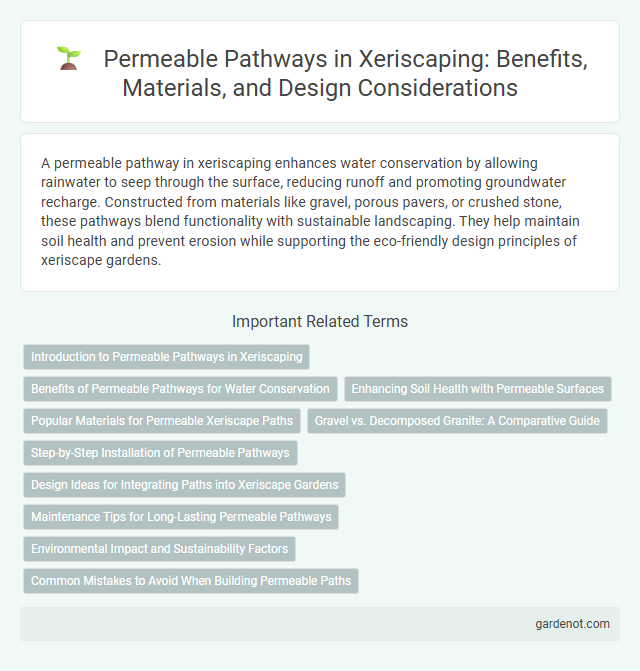A permeable pathway in xeriscaping enhances water conservation by allowing rainwater to seep through the surface, reducing runoff and promoting groundwater recharge. Constructed from materials like gravel, porous pavers, or crushed stone, these pathways blend functionality with sustainable landscaping. They help maintain soil health and prevent erosion while supporting the eco-friendly design principles of xeriscape gardens.
Introduction to Permeable Pathways in Xeriscaping
Permeable pathways in xeriscaping enhance water conservation by allowing rainwater to infiltrate the soil, reducing runoff and erosion. Materials such as porous pavers, gravel, and decomposed granite promote groundwater recharge and support sustainable landscaping. Integrating permeable pathways complements xeriscape principles by maximizing efficient water use and creating eco-friendly outdoor spaces.
Benefits of Permeable Pathways for Water Conservation
Permeable pathways enhance water conservation by allowing rainwater to infiltrate the soil, reducing runoff and replenishing groundwater supplies. These surfaces minimize erosion and filter pollutants, promoting healthier ecosystems. Integrating permeable materials like porous concrete or gravel supports sustainable xeriscape designs that maximize natural water retention.
Enhancing Soil Health with Permeable Surfaces
Permeable pathways significantly enhance soil health by allowing water to infiltrate directly into the ground, reducing runoff and promoting groundwater recharge. These surfaces support beneficial microbial activity and improve soil structure by maintaining aeration and balanced moisture levels. Utilizing materials such as porous pavers or gravel fosters sustainable landscaping practices essential for xeriscape designs.
Popular Materials for Permeable Xeriscape Paths
Popular materials for permeable xeriscape pathways include decomposed granite, crushed gravel, and permeable pavers, all known for their excellent water infiltration properties. These materials reduce runoff by allowing rainwater to seep directly into the soil, supporting water conservation goals intrinsic to xeriscaping. Incorporating native stone and recycled concrete further enhances durability while maintaining landscape sustainability.
Gravel vs. Decomposed Granite: A Comparative Guide
Gravel and decomposed granite are popular permeable pathway materials in xeriscape designs due to their excellent drainage and low water retention properties. Gravel offers superior permeability and durability, allowing water to flow freely into the soil while preventing puddling and erosion. Decomposed granite provides a compact, stable surface with a natural aesthetic but requires periodic maintenance to manage dust and compaction issues.
Step-by-Step Installation of Permeable Pathways
Begin the step-by-step installation of permeable pathways by excavating the designated area to a depth of 6 to 8 inches and compacting the soil base. Lay a landscape fabric to prevent weed growth, then add a 4-inch layer of crushed stone or gravel to facilitate water drainage. Place permeable pavers or porous materials on top, securely positioning them to maintain stability while allowing water infiltration through joints.
Design Ideas for Integrating Paths into Xeriscape Gardens
Permeable pathways in xeriscape gardens enhance water conservation by allowing rainwater to infiltrate the soil, reducing runoff and promoting groundwater recharge. Design ideas include using natural materials like decomposed granite, permeable pavers, or crushed stone to blend seamlessly with drought-tolerant plants and mulch. Integrating curves and varying widths in pathways provides visual interest while maintaining functionality and supporting native plant root systems.
Maintenance Tips for Long-Lasting Permeable Pathways
Maintaining permeable pathways in xeriscape landscapes involves regular cleaning to prevent debris buildup that can clog the surface and reduce water infiltration. Periodic inspection and prompt repair of cracks or settled areas help preserve structural integrity and ensure efficient drainage. Using a stiff broom or low-pressure washer keeps the pores clear, enhancing longevity and supporting sustainable water management.
Environmental Impact and Sustainability Factors
Permeable pathways in xeriscape design significantly reduce stormwater runoff by allowing rainwater to infiltrate the soil, minimizing erosion and groundwater contamination. These surfaces promote sustainable water management by replenishing aquifers and reducing reliance on municipal drainage systems. Utilizing permeable materials enhances soil health and supports urban biodiversity, contributing to environmentally responsible landscaping practices.
Common Mistakes to Avoid When Building Permeable Paths
Common mistakes when building permeable pathways include selecting materials with low permeability, such as non-porous concrete or compacted clay, which hinder water infiltration and cause runoff issues. Ignoring proper base preparation and drainage design leads to pathway instability and water pooling, reducing the overall effectiveness of xeriscaping. Overlooking weed barriers or failing to account for soil compaction can result in weed growth and decreased permeability, compromising the pathway's sustainability and low-maintenance goals.
Permeable pathway Infographic

 gardenot.com
gardenot.com